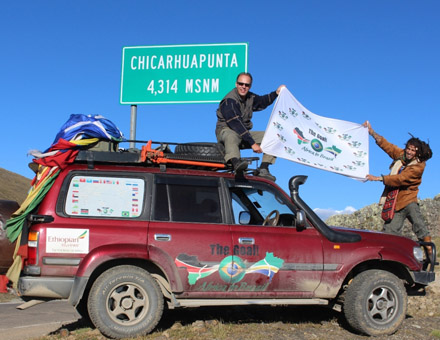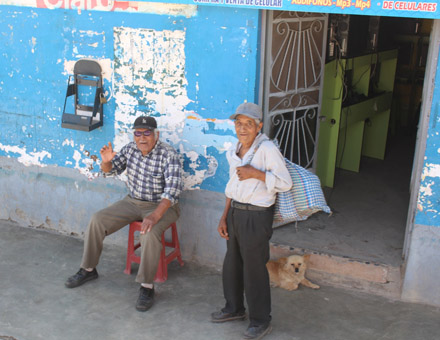
Two thousand meters below, a river rages through the valley floor. The sheer cliff next to the road without any shield whatsoever makes my stomach churn - what was I thinking when climbing onto Pele's roof for the crossing of the mountain pass?
The views of the Andean peaks in all directions are breathtaking and I would feel like being in the middle of nowhere if it wasn't for the traffic jam. Traffic jam in the Andes? I wouldn't have thought that this is possible but the entire road traffic to Bogota, Colombia's capital, runs over various high altitude mountain passes. Fuming trucks crawl up the steep road and we are right in between them. Overtaking is out of the question as there is an equally slow crawling line of trucks on the opposite lane, many truck drivers look anxious as they hope that their brakes don't fail during the precipitous descent. At times, traffic doesn't move at all – it would feel like a Nairobi traffic jam if it wasn't for the 1000 meter cliff on the side of the road!
On our way down the mountain pass, I suddenly sense with a shock that Pele's breaks are no longer working. Luckily, we have passed the steepest parts of the road and are able to continue with the motor break by cautiously driving in low gear. When I have the breaks checked at a garage, I realize with disbelief that the rear break pads are completely worn out. I am puzzled as we changed them barely 4000 kilometers ago in Central America - I am wondering what would have happened if the breaks had failed higher up on the steep sections of the mountain pass? Once again, I send a little prayer of thanks to our faithful guardian angel!
Two weeks later, we find ourselves on the way to the astonishingly 4314 meter high Chicarhuapunta Pass. Here in this remote part of the Peruvian Andes, there is no traffic at all but the windy road snakes in incredible turns along the near vertical mountain.
 Again, we are sitting on Pele's roof and I feel a mix of pure joy, thrill and horror as Fernando, our Brazilian travel companion, is trying to prove to us that he is a worthy heir to Ayrton Senna. Every now and then, we pass through tiny mountain villages – sun baked houses with tin roofs, women in colorful dresses and bowler hats carrying huge loads on their backs. Strangely, the kids in this area don't wave or even smile at us, some of them run away as we stop to take pictures. I have never experienced such wariness in kids and am wondering what causes this. A little later, we pass a memorial on the side of the rod that reads "Plaza de Ejecucciones" – Execution Square. A chill runs down my spine as I imagine the cruelties committed here during the times of the Maoist terrorist organization Sendero Luminoso. In the late 1980, it waged a guerrilla war resulting in the death and disappearance of at least 40,000 people, many of these in this area of the Central Andes. Might this be the reason why the kids are so shy towards us? Are strangers still seen as potentially murderous threats here?
Again, we are sitting on Pele's roof and I feel a mix of pure joy, thrill and horror as Fernando, our Brazilian travel companion, is trying to prove to us that he is a worthy heir to Ayrton Senna. Every now and then, we pass through tiny mountain villages – sun baked houses with tin roofs, women in colorful dresses and bowler hats carrying huge loads on their backs. Strangely, the kids in this area don't wave or even smile at us, some of them run away as we stop to take pictures. I have never experienced such wariness in kids and am wondering what causes this. A little later, we pass a memorial on the side of the rod that reads "Plaza de Ejecucciones" – Execution Square. A chill runs down my spine as I imagine the cruelties committed here during the times of the Maoist terrorist organization Sendero Luminoso. In the late 1980, it waged a guerrilla war resulting in the death and disappearance of at least 40,000 people, many of these in this area of the Central Andes. Might this be the reason why the kids are so shy towards us? Are strangers still seen as potentially murderous threats here?
We continue our journey higher up the mountain, there are no more villages and on top of Pele, it gets very chilly in spite of the bright equatorial sun. When we finally reach the pass, our jaws drop! On the other side of the pass, the majestic Cordillera Blanca stretches as far as our eyes can see – needle thin white glaciered peaks towering above the valley below and dazzlingly reflecting the afternoon sun. These are the "White Mountains", the highest mountain range in the world outside the Himalayas. They contain 22 summits above 6000 meters including the picture-perfect Alpamayo, the mountain depicted in Paramount Pictures' logo. For me, these are the most beautiful mountains in South America - I fell in love with them on my last trip to Peru 18 years ago and was looking forward to this moment of seeing them again!
The last couple of weeks have been full of adrenaline adventures in the Andes – we hiked in the beautiful Corcora Valley in Colombia's Zona Cafetera where 60m high slender palm trees rise into the sky making it look like a fairytale landscape out of The Lord of the Rings, experienced the thrill of white water rafting on furious Andean rivers, enjoyed the dramatic cycling descent under the shadow of an active volcano from the quaint town of Banos into the Amazon basin, explored the crystal clear mountain lakes of the striking moorlike Cajas National Park in Ecuador and - tied just with a harness to a zip line - flew like a bullet at 120km per hour into a narrow river Canyon.
 Aside from magnificent nature, we also experienced the friendliness and hospitality of Andean people. One evening, we enter the town of Machala in southern Ecuador and have a chance encounter with Freddy, a journalist, and his wife who are intrigued by Pele and our journey and spontaneously invite us for dinner in a local restaurant. On another day, particularly cold and misty, we stop at a roadside café after crossing a high mountain pass. We are greeted by a joyful group of locals playing guitar and singing along. They immediately offer us a self brewed drink and make space for us at the roaring fireplace where we warm up and have a delicious lunch of fresh trout.
Aside from magnificent nature, we also experienced the friendliness and hospitality of Andean people. One evening, we enter the town of Machala in southern Ecuador and have a chance encounter with Freddy, a journalist, and his wife who are intrigued by Pele and our journey and spontaneously invite us for dinner in a local restaurant. On another day, particularly cold and misty, we stop at a roadside café after crossing a high mountain pass. We are greeted by a joyful group of locals playing guitar and singing along. They immediately offer us a self brewed drink and make space for us at the roaring fireplace where we warm up and have a delicious lunch of fresh trout.
Back in the Cordillera Blanca, we visit the stunningly beautiful Lagunas Llanganuco, calm topaz lakes with spectacular views of snow covered glaciated peaks teetering incredibly high above. The clear water is so alluring that I can't resist the temptation of taking a bath in the lake – it takes about 30 seconds and I am out of the water again. The water temperature is only barely above 0 degrees, so cold that I am brusquely reminded of my unintentional bath in the Amur River in Siberia three months ago. I feel alive!

